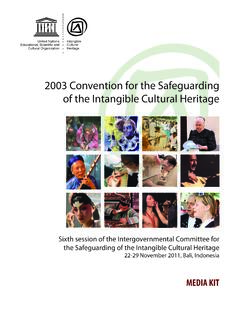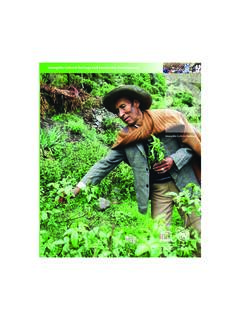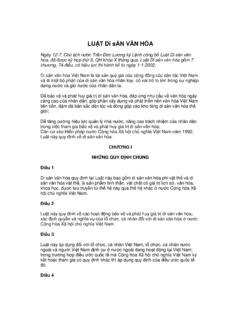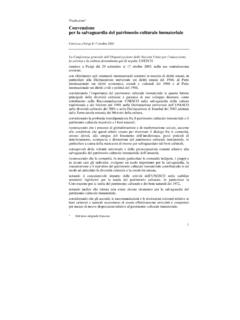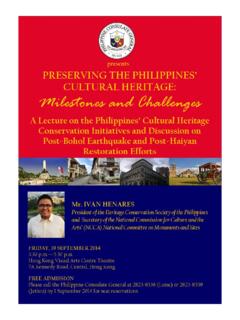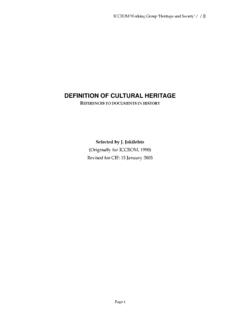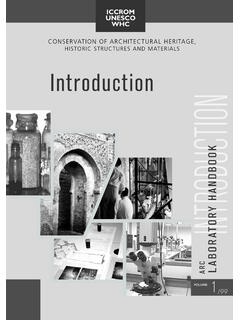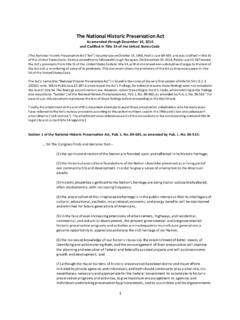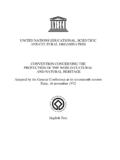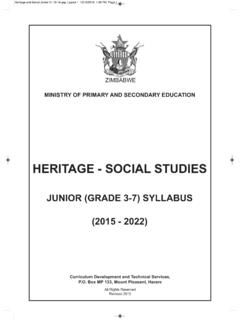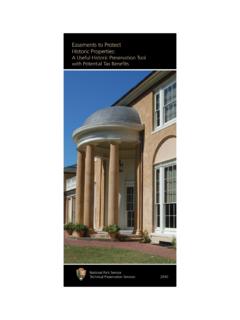Transcription of What is Intangible Cultural Heritage? - UNESCO
1 What is Intangible Cultural Heritage? Intangible Cultural HeritageWe s ha re Cultural e xp ressions tha t ha ve b een passed fr om on egeneration to a nother, have evolved in r esponse to t heirenvironments a nd contribute to giving us a sen se of identityand con tinu is Intangible UNESCO and Cultural heritageThere are things that we regard as important to preserve for futuregenerations. They may be significant due to their present or possibleeconomic value, but also because they create a certain emotion withinus, or because they make us feel as though we belong to something a country, a tradition, a way of life. They might be objects that can be heldand buildings that can be explored, or songs that can be sung and storiesthat can be told.
2 Whatever shape they take, these things for m part of aheritage, and this heritage requires active effort on our part in order tosafeguard it. The ter m Cultural heritage has changed content considerably in recentdecades, partially owing to the instruments developed by heritage does not end at monuments and collections of also includes traditions or living expressions inherited from ourancestors and passed on to our descendants, such as oral traditions,perfor ming arts, social practices, rituals, festive events, knowledge andpractices concerning nature and the universe or the knowledge and skillsto produce traditional crafts. UNESCO , which is the only specialized agency within the United Nationssystem with a specific mandate in culture, assistsits Member States in theelaboration and implementation of measures for an effectivesafeguarding of their Cultural heritage .
3 Among those measures, theadoption of the Convention for the Safeguarding of the IntangibleCultural heritage was a major step fordevelopingnew policies in the fieldof Cultural heritage . Cultural heritage ? Photo Samvel AmirkhanyanPhoto Conselho Das Aldeias WaiapiPhoto M. RevelardPhoto Vasil S. TOLE Photo Ugurhan/iStockphotoLLLLA lbanian Folk iso-polyphonyLLL The Carnival ofBinche, BelgiumLLThe Duduk and itsMusic, ArmeniaLOral and graphicexpressions of the Wajapi,BrazilJMosaic floor in Meknes, Cultural HERITAGEI ntangible Cultural HeritageWhile fragile, Intangible Cultural heritage is animportant factor in maintaining Cultural diversityin the face of growing globalization. An under -standing of the Intangible Cultural heritage ofdifferent communities helps with interculturaldialogue, and encourages mutual respect forother ways of life.
4 The importance of Intangible Cultural heritage isnot the Cultural manifestation itself but ratherthe wealth of knowledge and skills that istransmitted through it from one generation tothe next. The social and economic value of thistransmission of knowledge is relevant forminority groups and for mainstreamsocialgroups within a State, and is as important fordeveloping States as for developed ones. Intangible Cultural heritage is: Traditional, contemporary and living at thesame time: Intangible Cultural heritage doesnot only represent inherited traditions fromthe past but also contemporary rural andurban practices in which diverse culturalgroups take part; Inclusive: we may share expressions ofintangible Cultural heritage that are similar tothose practised by others.
5 Whether they arefrom the neighbouring village, from a city onthe opposite side of the wor ld , or have beenadapted by peoples who have migrated andsettled in a different region, they all areintangible Cultural heritage : they have beenpassed from one generation to another, haveLL The Carnival ofBarranquilla, ColombiaL The Oral heritage of Gelede,Benin, Nigeria and TogoPhoto Minisrty of Culture of the Republic of ColumbiaPhoto UNESCO / Yves Par fait KoffiIntangible Cultural heritage dependson those whose kno wledge oftraditions, skills and customs arepassed on to t he rest of thecommunity, from g eneration togeneration, or t o o ther Cultural heritage .5knowledge of traditions, skills and customs arepassed on to the rest of the community, fromgeneration to generation, or to othercommunities; Community-based: Intangible culturalheritage can only be heritage when it isrecognized as such by the communities,groups or individuals that create, maintainand transmit it without their recognition,nobody else can decide for them that a giv enexpression or practice is their heritage .
6 Evolved in response to their environmentsand they contribute to giving us a sense ofidentity and continuity, providing a link fromour past, through the present, and into ourfuture. Intangible Cultural heritage does notgiv e rise to questions of whether or notcertain practices are specific to a culture. I tcontributes to social cohesion, encouraging asense of identity and responsibility whichhelps individuals to feel part of one ordifferent communities and to feel part ofsociety at large. Representative: Intangible Cultural heritage isnot merely valued as a Cultural good,on acomparative basis, for its exclusivity or itsexceptional value. It thrives on its basis incommunities and depends on those whoseK The Bistritsa Babi Archaic Polyphony, Dancesand Rituals from theShoplouk Region, BulgariaPhoto CNRPAHP hoto Mila SantovaLKun Qu Opera, ChinaK The Ahellil of Gouara,AlgeriaPhoto Chinese Academy of ArtsIn Cambodiaa Khmer shadow theatre featuringleather work puppets, the Sbek Thom, takes placethree or four times a year on specific occasionsand has evolved from being a ritualistic activity inthe fifteenth century to becoming an artistic formin the present Baltic Song and Dance Celebrations in Latvia,Estonia and Lithuaniamaintain and develop theregion s tradition of performing folk art.
7 Large-scalefestivals lasting sever al days take place every fifthyear in Estonia and Latvia and every fourth year inLithuania providing a showcase for up to 40,000,mainly amateur, singers and dancers. The Zafimaniry communities of Madagascarhave developed and continue to practise theirknowledge and skills revolving around wood,from forestry to building to the elaborateornamental sculpting of practically all woodensurfaces whether decorative features orfunctional objects such as tools. In most regions of Mexico, communitiescommemorate the temporary return to Earth ofdeceased relatives and loved ones on el D a delos Muertos (Day of the Dead). These festivities,which fuse pre-Hispanic religious rites withCatholic feasts, take place at the end of Octoberto the beginning of November each year alsomarking the annual cycle of the cultivation ofmaize, the country s biggest food making in Ugandainvolves some ofhumankind s oldest knowledge, a prehistorictechnique that predates the invention ofweaving.
8 Barkcloth is mainly worn atcoronation and healing cer emonies, funeralsand Cultural gatherings, but is also used forcurtains, mosquito screens, bedding andstorage. With the introduction of cotton cloth byArab caravan traders in the nineteenth century,production slowed and barkcloth s Cultural andspiritual functions diminished, until its revival inrecent a living heritageJust like culture in general, Intangible heritage isconstantly changing and evolving, and beingenriched by each new generation. Manyexpressions and manifestations of intangiblecultural heritage are under threat, endangeredby globalization and Cultural homogenisation,and also by a lack of support, appreciation andunderstanding. If Intangible Cultural heritage isnot nurtured, it risks becoming lost for ever , orfrozen as a practice belonging to the this heritage and passing it on tofuture generations strengthens it, and keeps italive while allowing for it to change and order to safeguard Intangible culturalheritage, we need different measures from theones used for conserving monuments, sites andnatural spaces.
9 For Intangible to be kept alive, itmust remain relevant to a culture and beregularly practised and learned withincommunities and between Al-Sirah Al-HilaliyyahEpic, EgyptIThe Samba de Roda ofRec ncavo of Bahia, Cultural HERITAGEP hoto CULTNATP hoto National Museum of CambodiaPhoto UNESCO /Latvian Folk CentrePhoto Minist re de la Culture de MadagascarPhoto Lor enzo ArmendarizPhoto WalusimbiPhoto Luiz Santoz / UNESCO7 For Intangible to b e kept a live, it must r emain r elevant t o aculture and be regularly practised and learned withincommunities and between generations. Cultural HERITAGEC ommunities and groups who practise thesetraditions and customs everywhere in the wor ld have their own systems for transmittingtheir knowledge and skills, usually dependant onwor d of mouth rather than written texts.
10 Safeguarding activitiesmust therefore alwaysinvolve the communities, groups and, whereappropriate, individuals that bear such is a risk that certain elements of intangiblecultural heritage could die out or disappearwithout help, but how can we safeguard andmanage a heritage that is constantly changingand part of living culture without freezing ortrivializing it? Safeguarding them is about thetransferring of knowledge, skills and meaning. In other wor ds, safeguarding focuses on the processes involved in transmitting, orcommunicating Intangible Cultural heritage from generation to generation, rather than onthe production of its concrete manifestations,such as a dance perfor mance, a song, a musicinstrument or a craft.
